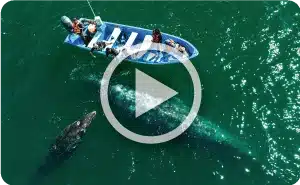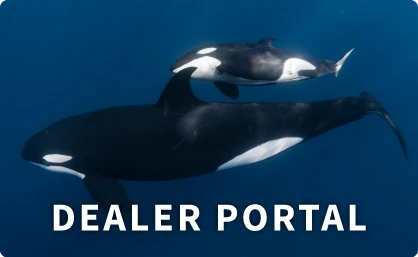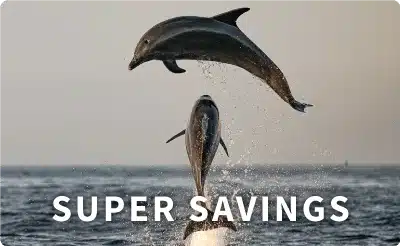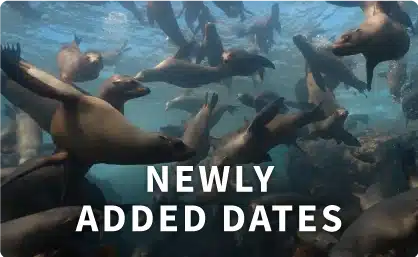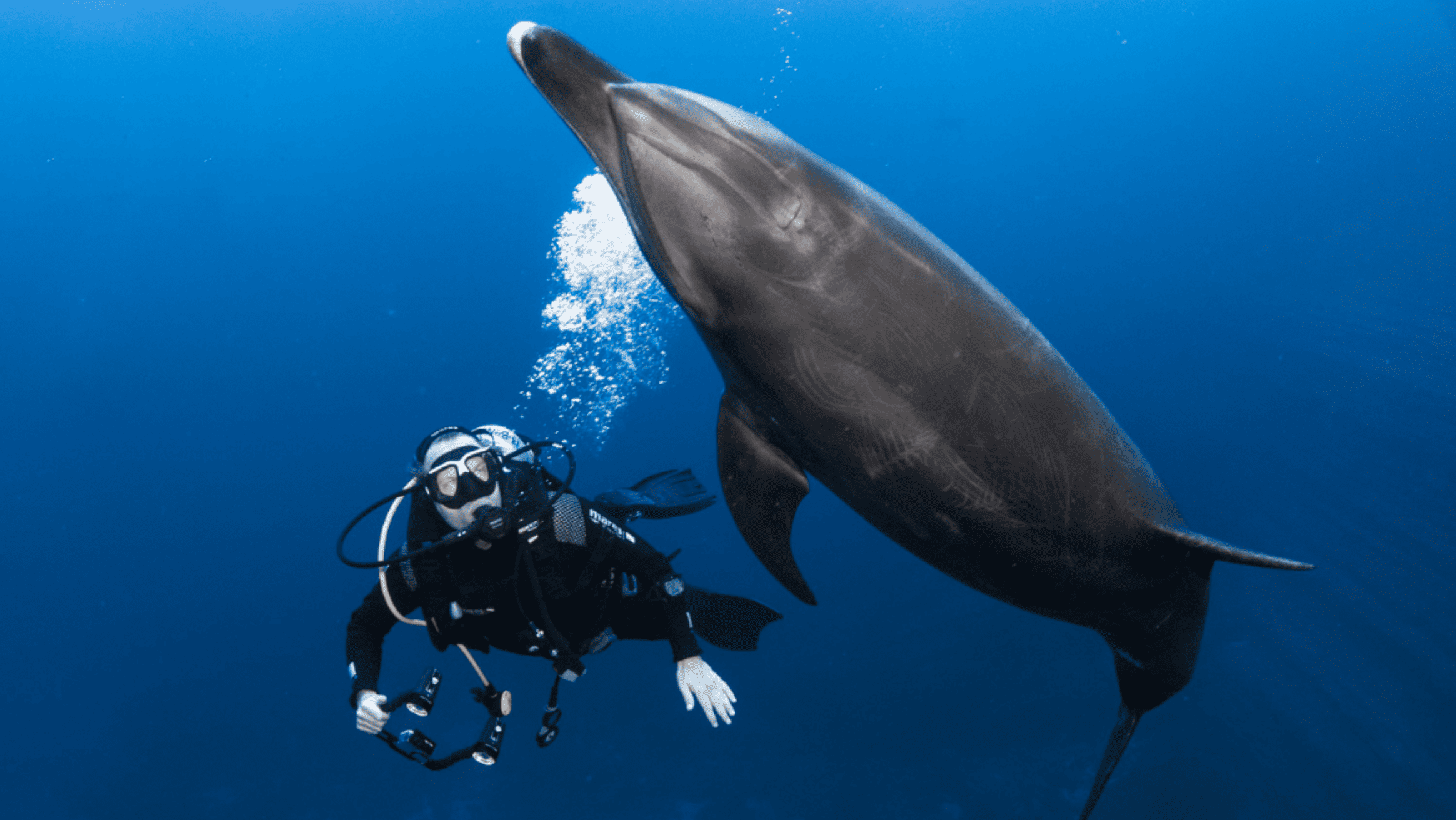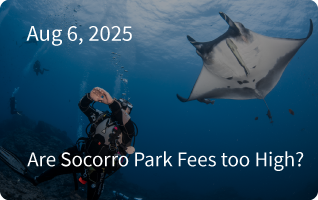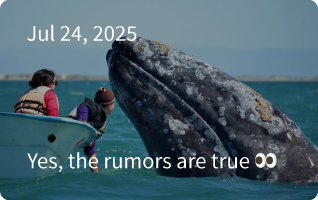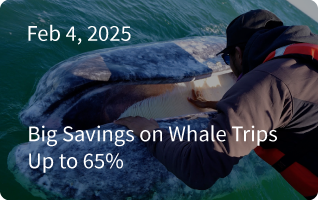Whale Watching In Baja: Species, Seasons, And The Best Spots
2025-08-08
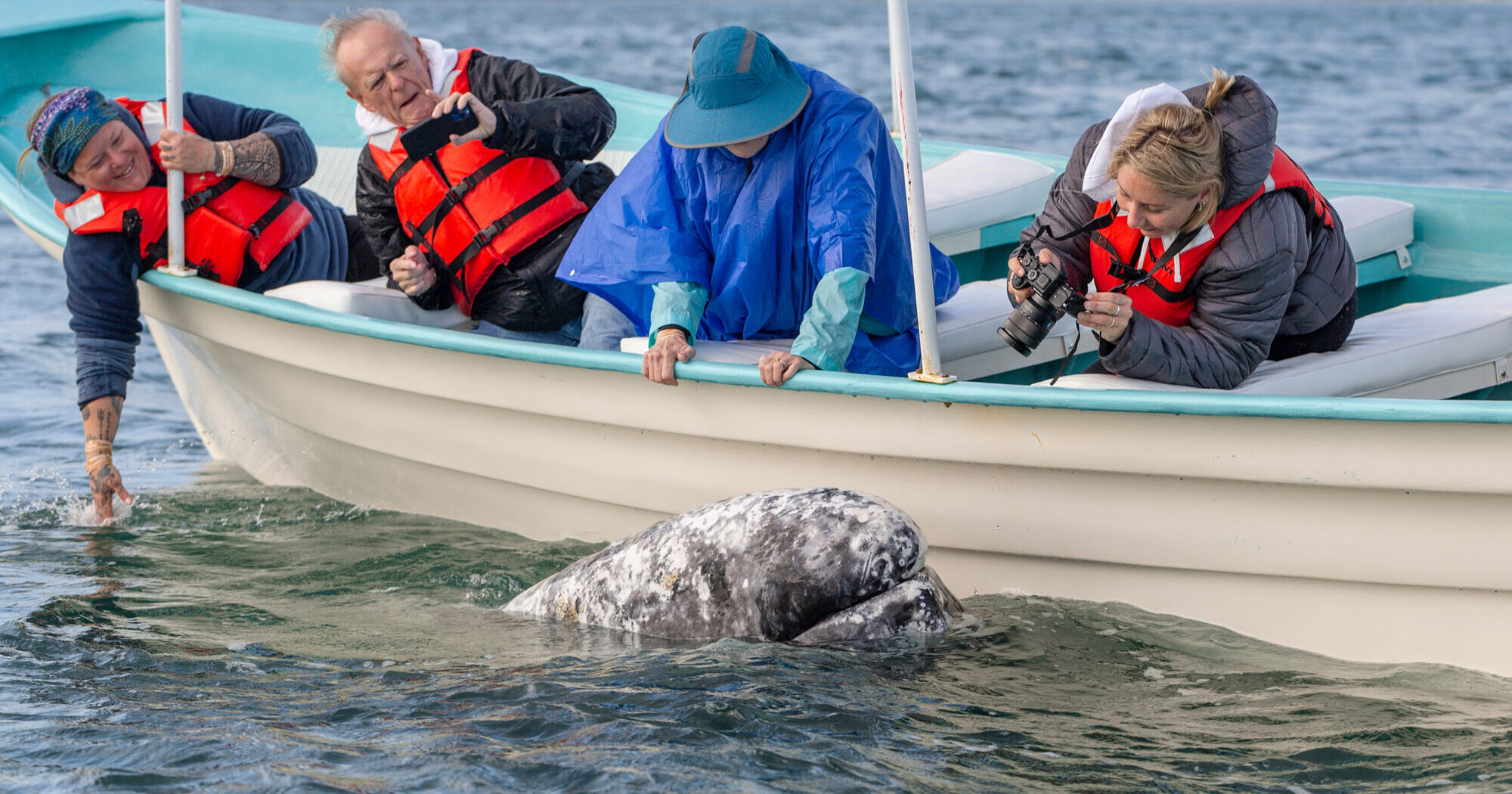
Whale watching in Baja, Mexico, provides a rare front-row seat to one of nature’s greatest migrations and offers intrepid travelers wild and wonderful whale encounters. It’s an extraordinary experience not to be missed!
Table of Contents:
- Why Baja California Is Great for Whale Watching
- Whale Species & Other Marine Life
- Migration Season – Best Time to Visit
- Best Spots in Mexico for Whale Watching
- Ethical Whale Watching
- Combo Tours – Other Activities in Baja
- Frequently Asked Questions
Why Baja California Is Great For Whale Watching?
Baja California Sur, on Mexico’s west coast, is one of the world’s top regions for whale watching. Its protected marine environments have great biodiversity, and every year, Baja’s sheltered waters attract thousands of migrating whales. Therefore, during whale watching season, Baja’s visitors typically encounter a wide variety of whales and other incredible wildlife. You might see humpbacks breaching offshore, catch a glimpse of an elusive blue whale, or spot gray whales nursing their calves.
Friendly Gray Whales
In addition to its natural beauty, Baja California Sur is especially famous for close-up whale encounters with its “friendly” gray whales, which often approach boats and seek human interaction. An extraordinary behaviour that is unique to Baja’s lagoons, particularly San Ignacio Lagoon.
Conservation History
The Baja Peninsula has a long history of marine conservation. Commercial whaling once pushed some whale species to the brink of extinction. By the 1970s, Baja’s gray whale population in particular, had become dangerously low. Recognising the threat, local communities and environmental groups came together to protect key whale habitats, and led to the establishment of El Vizcaíno Biosphere Reserve and the Loreto Bay National Marine Park, among others.
Thanks to stricter protections, sustainable tourism, and global whaling bans, whale numbers have made an impressive comeback — a true success story for marine conservation.
What Whale Species Can You See In Baja?
Baja’s waters are home to several whale species, including gray whales, humpbacks, fin whales, sperm whales, Bryde’s whales, and blue whales, the world’s largest animal!
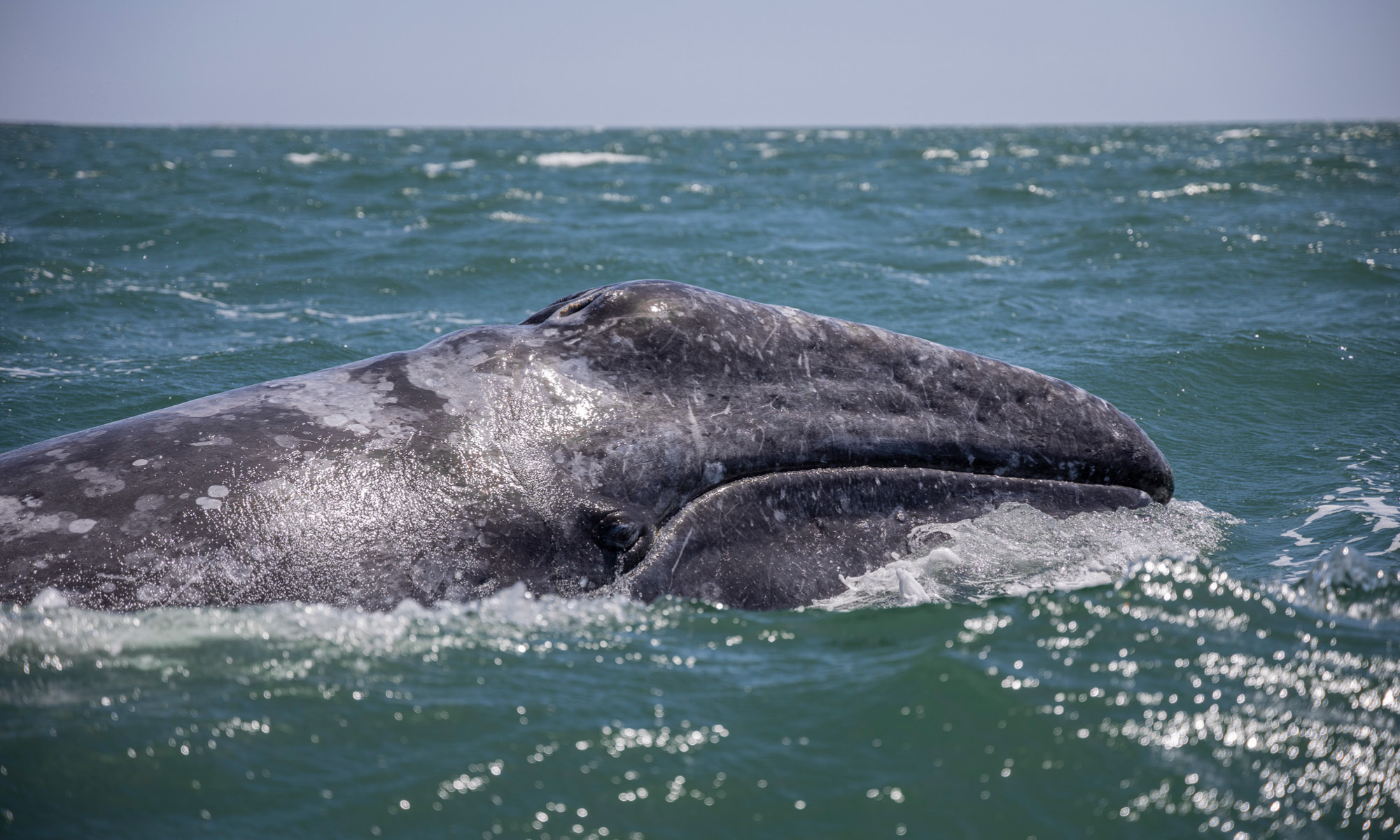
1. Gray Whales: The Stars of San Ignacio Lagoon
Along Baja’s Pacific coast, thousands of migrating gray whales gather in sheltered lagoons, providing spectacular whale watching encounters. In San Ignacio Lagoon, the gray whales are particularly famous and affectionately called the “friendly ones” because they tend to approach boats, getting eye-to-eye with visitors, and even allowing gentle touches. This unique behavior is found only in the breeding lagoons of Baja Mexico.
You can identify gray whales by their mottled gray skin and embedded barnacles.
At the end of our tour, two whales came very close to our panga. Even though they approached calmly, I was intimidated because they were huge, at least 25 feet long! One female came even closer on our starboard side… it felt completely natural to reach out and touch her. She stayed in that position for several minutes. It was an encounter entirely on her terms — that was the most magical part. No engines running, no chasing. They came to us. She was curious, and we simply witnessed what she wanted to share.“
Celina (Guest), January 17, 2024
Related Reading: ‘Whale Watching in San Ignacio Lagoon: Where the Gray Whales Call the Shots’
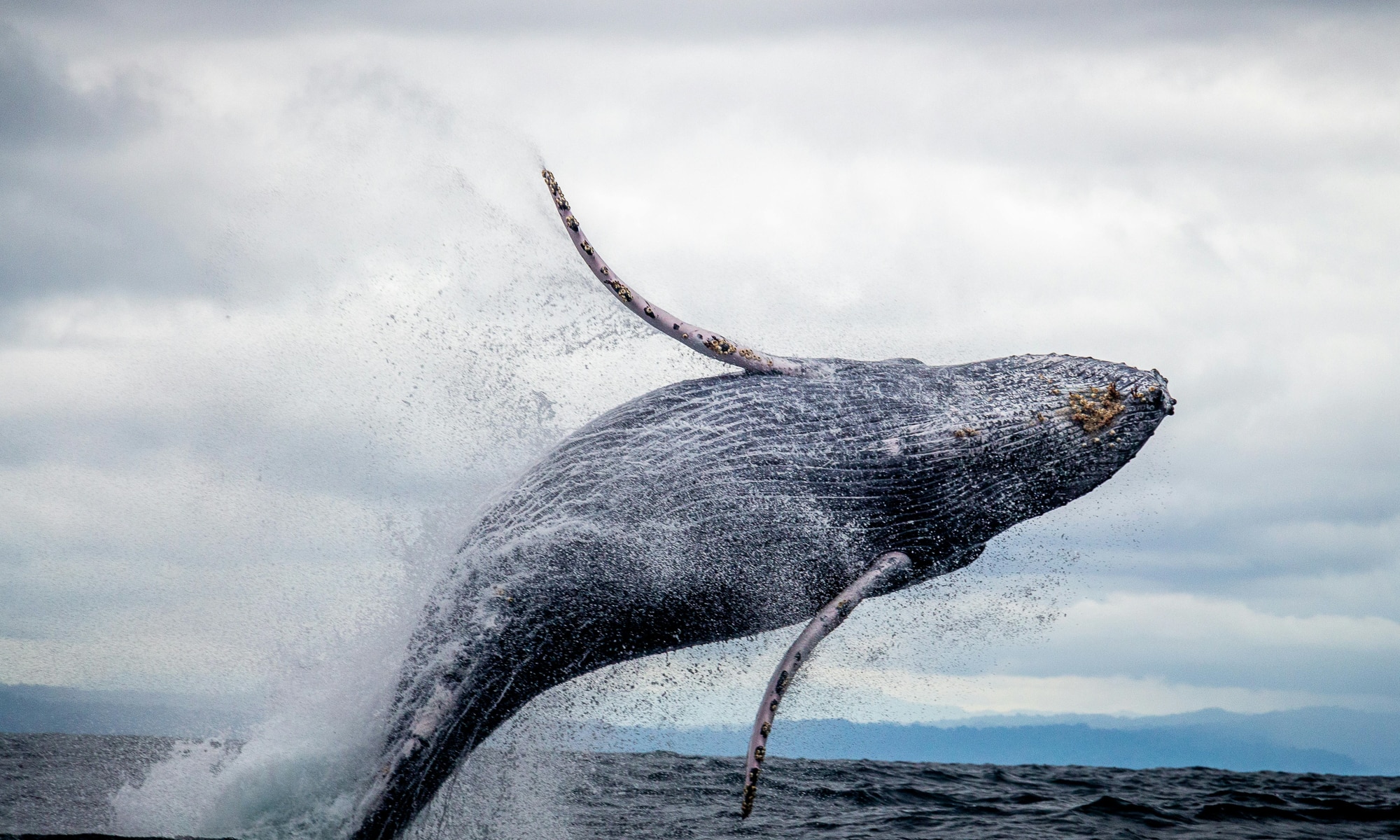
2. Humpback Whales
Throughout the winter months, humpback whales are a regular sight around the Baja California Peninsula. They are frequently spotted offshore as they migrate past Cabo San Lucas and through to the Sea of Cortez. Humpbacks swim in pods (or groups) of up to a dozen at calving grounds, and in smaller pods of three to four during migration.
Humpbacks are real crowd-pleasers, known for their acrobatic breaches and tail slapping, in addition to their majestic whale songs. The sound can travel underwater for several miles, so if you’re lucky, you may hear their hauntingly beautiful music.
Adult humpbacks grow to an impressive 14–15 m (46–50 ft) and are easy to recognize thanks to their knobbly heads, long pectoral fins, and distinctive tail flukes.
On our last afternoon in the Sea of Cortez, we witnessed the greatest show on the water, ever! We watched in utter amazement as three humpback whales put on a show to end all shows! Tail flapping, pectoral flapping, and full breeching!“
Elise (Guide), March 11, 2025
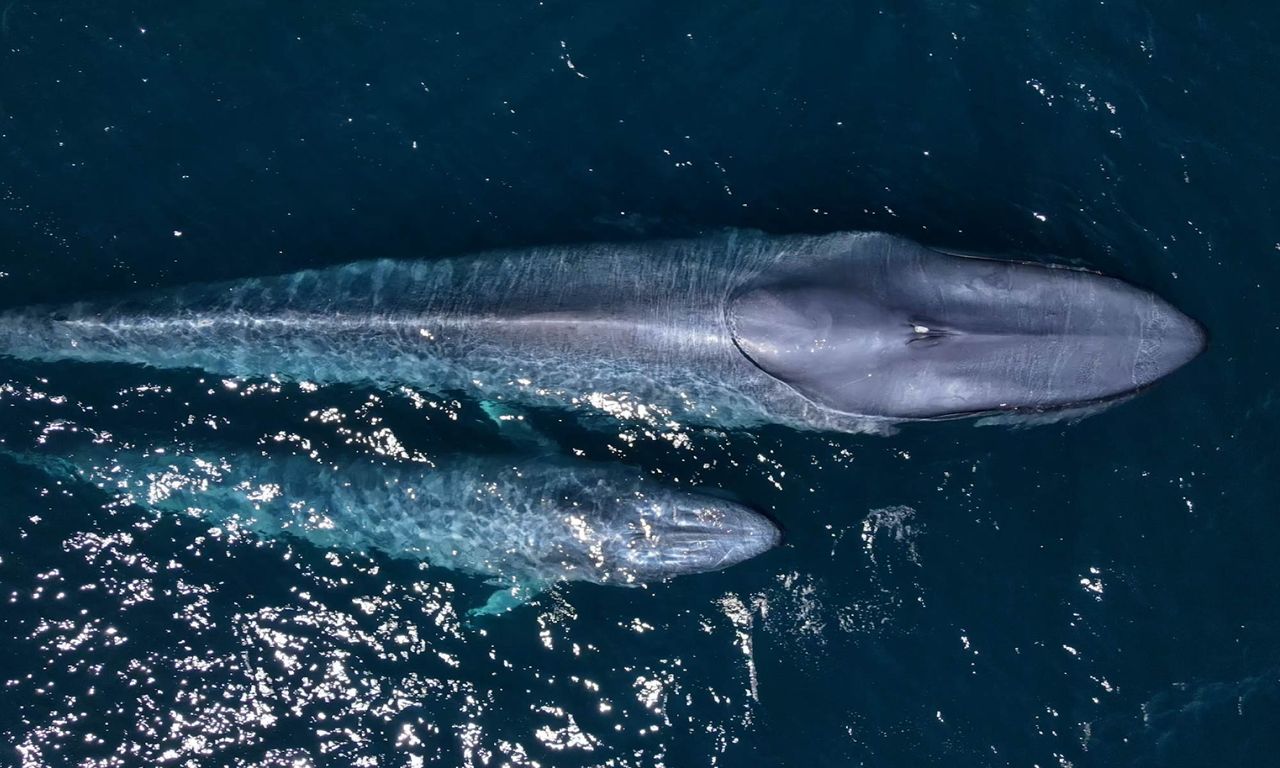
3. Blue Whales
Every winter, blue whales can be observed on whale watching tours in the Sea of Cortez since they migrate to Mexico’s warm, nutrient-rich seas. You can recognize blue whales mostly by their immense size; they have a long, slender body and, in the North Pacific, grow up to about 27m (90ft).
Their smooth, blue-gray skin appears light blue underwater. To spot these elusive giants, look out for tall, column-like spouts when they surface to breathe.
It started with dolphins before breakfast… Then we were picked up by Tequila in his panga to go blue whale watching. And what an exhilarating few hours! We were super lucky with our day and conditions, and had one big blue whale reappear for us many times. Plus, we could see the spouts of at least three other blue whales in our local area. They are truly awe-inspiring creatures!”
Clair & Greta (Guests), February 06, 2024
Related Reading: ‘Blue Whales & Fin Whales, One of the Most Amazing Big Animals I Have Ever Seen’
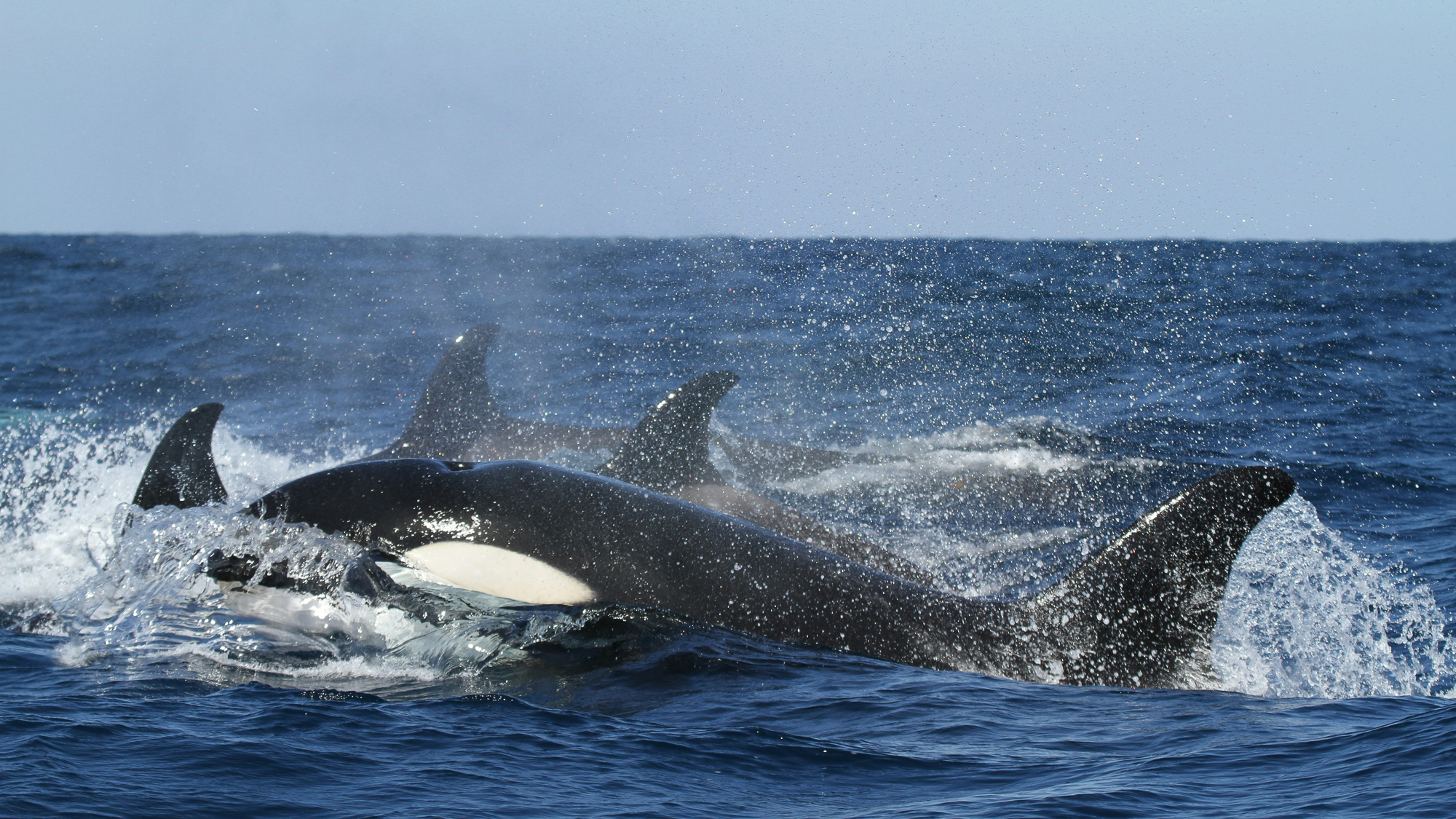
4. Occasional Sightings: Orcas, Dolphins, And More
Other marine mammals, such as orcas, false killer whales, dolphins, pilot whales, seals, and sea lions, can also be spotted in Baja’s waters. While sightings are less predictable, they add a thrilling surprise to any whale watching trip.
Fun fact: Despite their names, orcas (killer whales), false killer whales, and pilot whales aren’t true whales at all. They’re actually members of the oceanic dolphin family (Delphinidae)! These species are known as “toothed whales,” but are more closely related to dolphins than to baleen whales like humpbacks or blues.
Whale Migration: When To Experience The Best Whale Watching in Baja California Sur
Most whale species follow a migratory cycle as old as time, and due to its unique conditions, thousands of whales have the Baja Peninsula on their annual travel list. Some populations of humpbacks travel to breed and calve in Baja’s coastal waters, and many gray whales return to the same protected breeding lagoons year after year.
In contrast, blue whales are rarely seen giving birth here. Instead, they migrate along the coast of North America and spend winter off of Mexico and Central America. They are attracted to Baja’s nutrient-rich waters in search of their favourite food, krill.
The Baja California whale watching season typically runs from late December through to April. Timing your visit is crucial for the best whale watching experience.
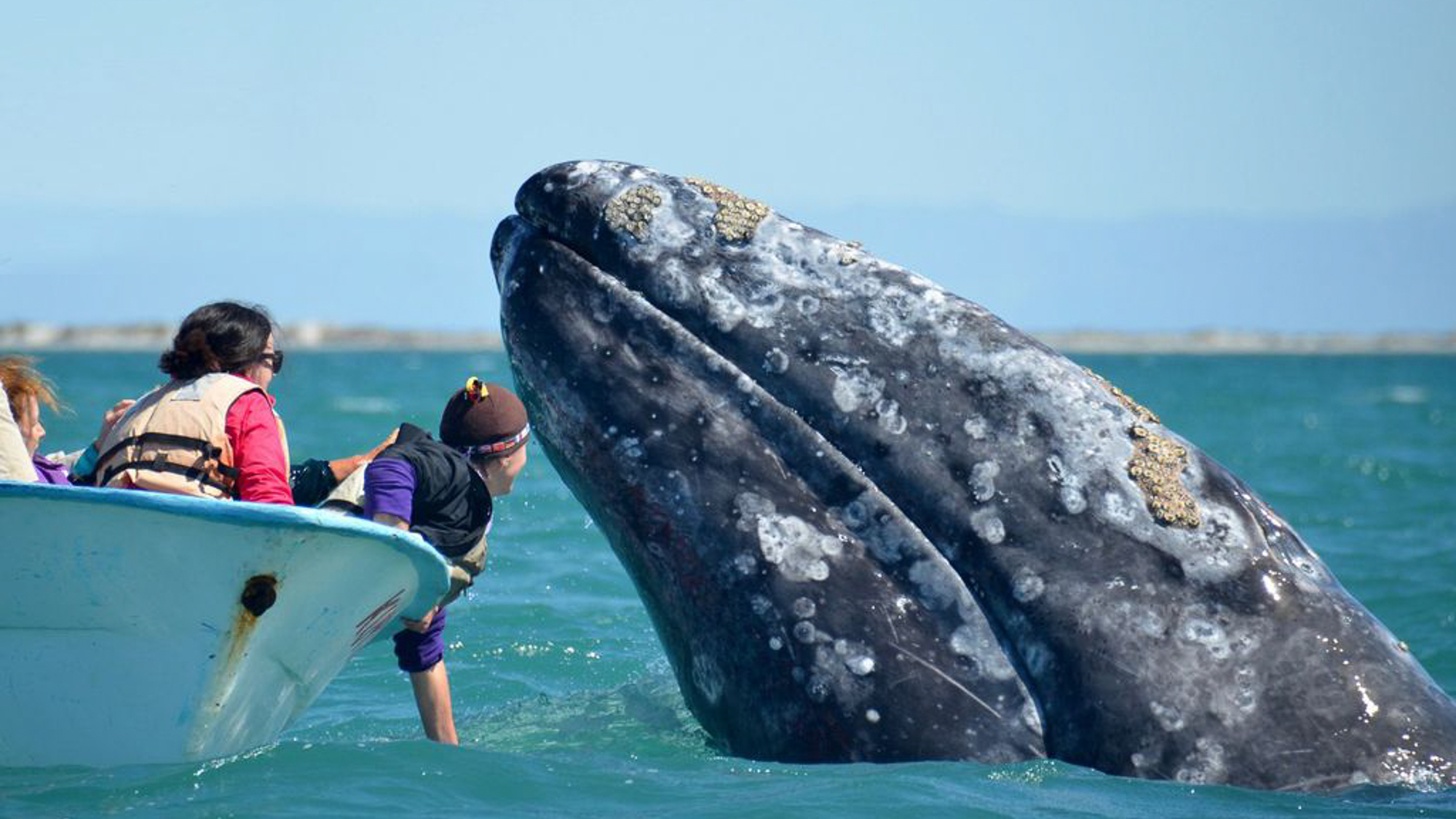
Gray Whale Season in Baja: The Return of the Gentle Giants
Every year, thousands of gray whales swim around 6,000 miles from their frigid feeding grounds in the Arctic Ocean to the protected lagoons of Baja, Mexico. The lagoons are a haven for migrating gray whales, a place for courtship and mating rituals, and an ideal environment to birth and raise calves.
As the gray whale migration season develops, so does their behaviour:
| Months | Whale Activity | Best For |
| December–January | Arrival, start of courtship rituals | Witnessing first arrivals and breeding behavior |
| February–March | Birthing, nursing, mother-calf pairs | Close encounters and interactive behavior |
| April | Preparation for return migration | Playful calves practice swimming and breaching |
Winter Arrival and Breeding Season
Gray whales usually begin to arrive in Baja from the end of December into mid-January. During the early part of the season, visitors observe courtship behaviors and the arrival of the first pregnant females, who carry their calves for an impressive 12-13 months before giving birth. Incredibly, newborns already weigh over 900kg (2,000 pounds)!
Mothers and Calves in Spring
February through March is a popular time for whale watching in Baja because many mother-calf pairs can be observed. The sheltered lagoons provide the perfect environment for calves to nurse, learn, and play. As such, visitors can expect some of the most interactive encounters, with whales often approaching boats and displaying nurturing behaviors.
Late Season and Calf Development
In April, whales start preparing for the return journey north to their Arctic feeding grounds. Calves need to build strength for migration and become more playful and active as they grow. Whale watching in April provides a unique opportunity to see energetic young whales.
Where To Find The Best Whale Watching In Mexico
The best whale watching in Mexico can be found around Baja California Sur, in both the Pacific Ocean and the Sea of Cortez. Whale watching in the Baja Peninsula is centred around several world-renowned locations, each with unique features.
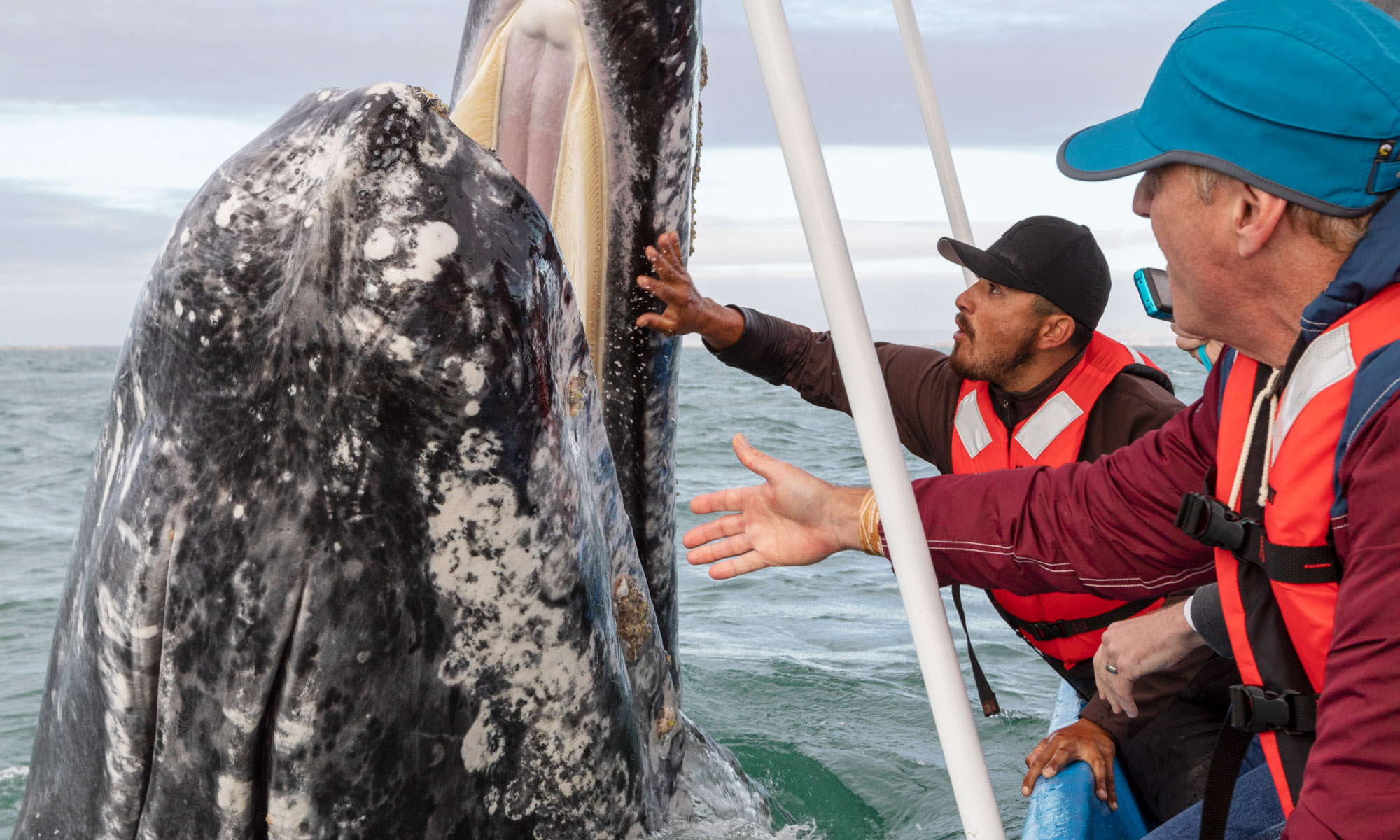
1. San Ignacio Lagoon: Close Encounters With Gray Whales
San Ignacio Lagoon is a remote, sheltered bay fringed by desert and mangroves, with calm, shallow waters that create a sanctuary for migrating gray whales. Expect close, respectful interactions with whales in a tranquil setting.
Visitors can experience the planet’s most extraordinary whale interaction with “friendly” gray whales, which approach boats and sometimes even accept gentle touches from visitors. Wondering if it’s really okay to touch the whales? Check out our article on ‘Touching the Gray Whales’ to learn more about this unique and respectful interaction.
Access: This remote location is a long journey for a simple day trip; by the time you arrive, it’s nearly time to make the return journey! That’s why we recommend a multi-day stay. It gives you more chances to experience the incredible close-up encounters with the gray whales you’re longing for.
Conservation: San Ignacio Lagoon is a UNESCO World Heritage site where strict protections prevent overcrowding and ensure minimal disturbance to the whales. Local operators follow best practice agreements that go beyond official regulations to protect the whales’ natural behavior. Boat numbers are limited in the observation zone, and each whale watching session is capped at 90 minutes, giving both whales and visitors a break between outings. Multiple sessions run daily, but always with built-in rest periods so whales have time to nurse calves, socialize, and just be whales.
When to visit: The best time to visit gray whales in San Ignacio Lagoon is from mid-January to mid-April.
Whale watching in San Ignacio Lagoon is THE most spectacular experience! Being up close with the gray whales and learning more about their life and habits has been wonderful. The staff and nature guides have been so accommodating and have made our stay comfortable and informative.”
Kathleen (Guest), February 28, 2025
2. Magdalena Bay: Gray Whale Tours
Magdalena Bay is an expansive bay system with multiple whale watching zones. It’s larger and less remote compared to San Ignacio, which means there can be more flexible tour options available; however, the whale encounters here are often less intimate.
Access: Day trips and multi-day camping tours are available. The area is accessible from towns like Puerto San Carlos and Puerto Adolfo López Mateos.
Conservation: While official guidelines exist, there are currently no set limits on the number of boats or the length of tours, as there are in San Ignacio Lagoon. This can sometimes put pressure on the whales and impact the overall experience for visitors. Providing quiet periods with no whale watching allows the whales to rest, nurse their calves, and carry out their natural behaviors — something especially important for the health and well-being of reproducing whales.
For more information, see the official publication from Gray Whale Research in Mexico: ‘Friendly whales: Why do we need best practices for their observation?‘
When to visit: Gray whale tours in Magdalena Bay are typically available from late December to April, with the prime season generally starting from mid-January.
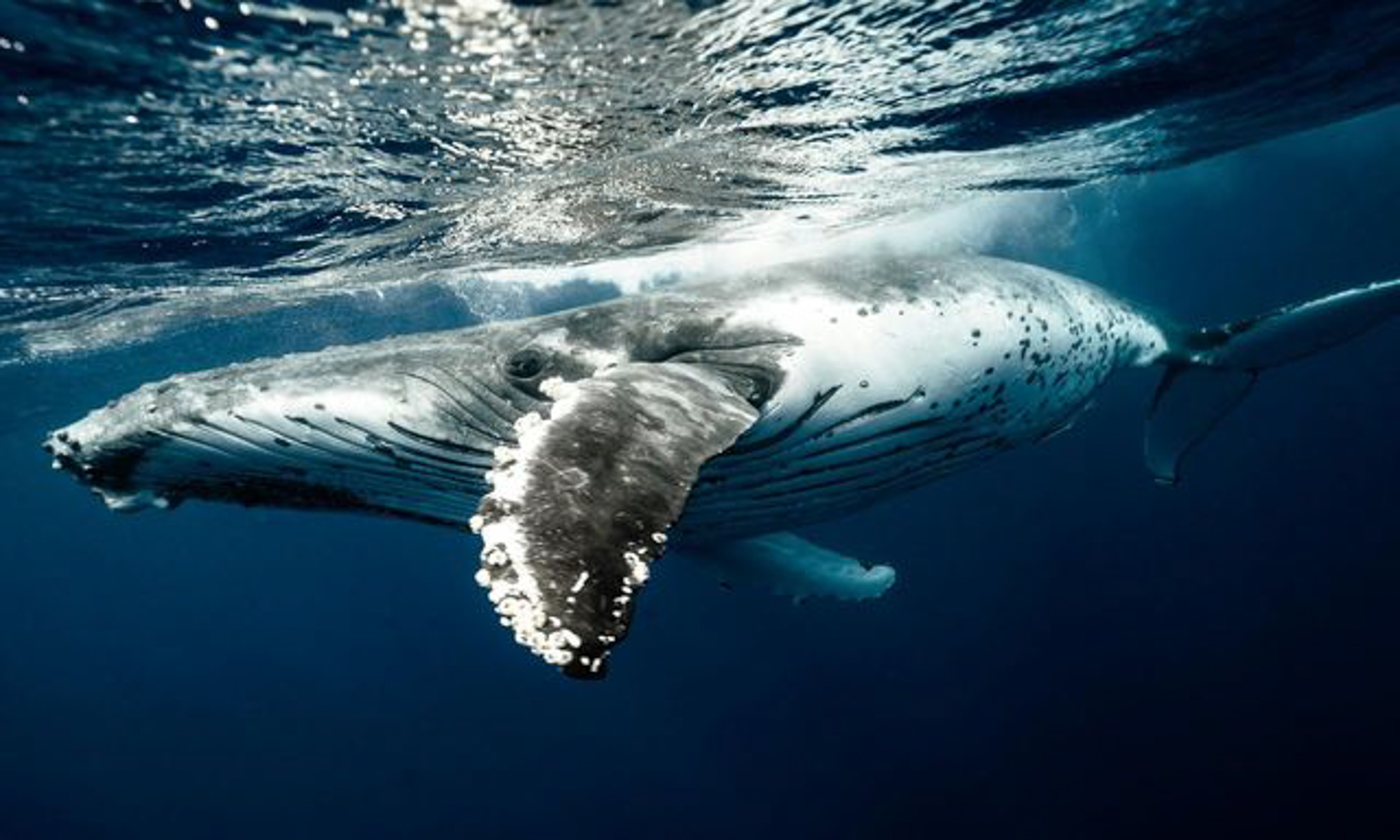
3. Whale Watching In The Sea Of Cortez: Loreto And La Paz
The coastal towns of Loreto and La Paz are top departure points for single or multi-day whale watching tours in the Sea of Cortez. They boast calm, clear waters and offer opportunities to spot humpback whales, blue whales, and other wildlife, including playful sea lions, occasional whale sharks, and an array of birds.
Access to La Paz: You can fly directly into La Paz International Airport (LAP) from select U.S. cities, or it’s just a 2-hour drive away from Los Cabos International Airport (SJD).
Access to Loreto: You can fly into Loreto International Airport (LTO), located about a 10-minute drive from the town. It’s super easy to hop on a shuttle or grab a taxi straight to whale-watching tours.
When to visit: The best time for whale watching in the Sea of Cortez is from December to April. Visitors observe the highest number of blue whales from February to April, while humpbacks are seen throughout the season.
Want to explore both sides of the Baja Peninsula and witness all of this incredible marine life? Baja Expeditions offers the best of both, with our ‘San Ignacio + Baja Ultimate Whales’ tour. A trip that combines extraordinary close encounters with gray whales and epic whale watching in Cabo and the Sea of Cortez.
What To Expect On A Whale Watching Tour In Baja
The incredible wildlife and spectacular scenery in Baja make whale watching tours a truly unforgettable adventure. There are two main options for whale watching: single-day trips lasting 2-4 hours or multi-day experiences that can range from 2-12 days.
Whale watching tours usually include meals or snacks, commonly of local seafood and Mexican cuisine. Most destinations are pretty remote, so expect limited cell service and an itinerary focused on the natural world.
Why Opt for a Multi-Day Tour?
Whales don’t run on schedules like we humans do; nothing is guaranteed, which makes each wild encounter so special! Therefore, if you’re hoping to maximise your sightings and create deeper connections with these gentle giants, we highly recommend opting for a multi-day experience. If the whales or the weather don’t cooperate one day, it means you will still have other opportunities.
More time on the water means more chance encounters. When comparing operators, be sure to check how many whale watching excursions are included in the package. Some tours include one whale watching session per day with optional add-ons, while others may include up to 2-3 sessions a day, depending on weather and demand.
Multi-Day Tours: Accommodations And Amenities
The type of accommodation available varies depending on location. For whale watching in Cabo and La Paz, you’ll find a mix of hotel stays and liveaboard options; in more remote areas, you’ll find campgrounds ranging from luxury glamping setups to more basic tents or cabins where amenities can range from solar showers and shared facilities to heated rooms complete with Wi-Fi, hot water, and private bathrooms.
Types of Boats and Physical Requirements
Traditional Mexican fishing boats, called pangas, are commonly used for whale watching trips. These small boats allow for close whale encounters and a more personal experience. In contrast, larger boats, or liveaboards, are used for bigger tour groups or to host longer whale watching excursions.
Visitors need some mobility to safely board boats; if necessary, consider checking accessibility with operators before booking.
Expert Guides and Safety Briefings
Here at Baja Expeditions, all of our whale watching tours include trained guides, life jackets, and safety briefings. The briefings include fun facts about the marine life as well as important wildlife protection protocols.
In addition, our expert guides are trained to facilitate memorable interactions with the whales that are also ethical and safe.
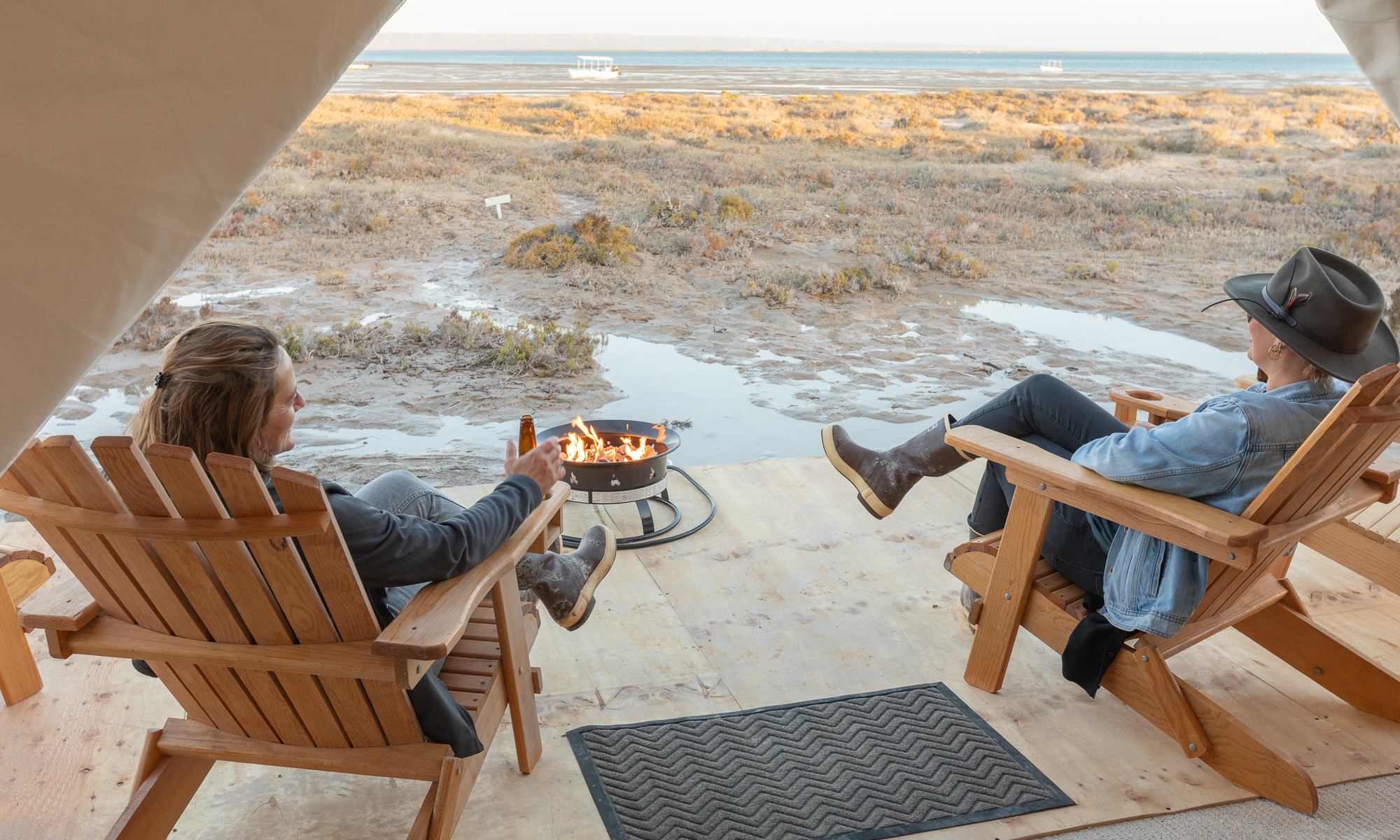
‘A Room With a View’ at Baja Expeditions’ Luxury Camp
At San Ignacio Lagoon, accommodations vary depending on your desired comfort level, budget, and whether you arrive by bus, self-drive, or by fly in. These typically fall into the following three categories:
1. Basic Camping
- Features: Tents, local cuisine, with shared showers and bathroom facilities
- Price Range: $
- Access: Self-arrival
2. Eco-Camps
- Features: Rustic cabins, local cuisine, with shared showers and bathroom facilities
- Price Range: $$
- Access: Self-arrival
3. Glamping
- Features: Premium tents/cabins, gourmet meals, hot showers, private bathrooms
- Price Range: $$$
- Access: Fly in
All-inclusive San Ignacio Lagoon & Gray Whales Adventure: mid-range price, yet offers exceptional value
It includes private fly-in from Cabo, fine dining, and comfortable glamping or luxury camp accommodations with all the comforts of a hotel. There’s a separate dining tent, a club tent with an honor bar, nightly presentations from our naturalists, and a variety of activities
Prices for the 4-day / 3-night experience, including 3 nights’ accommodation and around 8 whale watching sessions, start at US$2,495 per person, based on double occupancy. All glamping tents are windproof and heated, with twin or queen beds, real linens, ensuite bathrooms with hot showers, and 24-hour electricity. Family tents are available too.
If you’d like a bit more space, the Luxury Camping option adds a dresser and a separate sitting area with a couch and comfy chairs.
Is Whale Watching in Baja Ethical? Responsible Whale Encounters
Ethical whale watching is essential for the protection of Baja’s whale populations, and activities are regulated by Mexico’s environment ministry, SEMARNAT. At Baja Expeditions, we are committed to sustainable practices, such as limiting boat numbers and following strict approach guidelines.
Our team of experienced marine biologists guides each trip and educates visitors about the whales and other marine life. Their training and experience ensure safe and respectful interactions, allowing unforgettable experiences without negatively impacting the whales. For example, at San Ignacio Lagoon, close whale encounters only occur when whales voluntarily approach us.
In addition, tourism revenue supports local conservation efforts and provides alternatives to fishing in whale habitats. Resident communities are engaged with conservation efforts, and our local captains share a deep connection with their environment.
Planning Your Whale Watching Tour In Mexico
Whale watching in Baja is a transformative experience, connecting visitors with some of the ocean’s most majestic creatures. At Baja Expeditions, we specialize in creating memorable adventures with a blend of luxury, expertise, and a deep respect for wildlife. Let us take care of all the tour travel plans and logistics, ensuring a smooth and enjoyable vacation.
Start booking your unforgettable journey with Baja Expeditions today!
Top Tips For Booking Whale Watching Tours in Baja
Baja’s whale watching season is limited, so secure your spot early! Booking in advance is a must; reserve your place at least 3-6 months ahead of the peak season. Some key questions to ask tour operators before booking are their group sizes, safety protocols, cancellation policies, and what amenities are included.
Packing Essentials For Whale Watching
Whale watching tours will expose you to the elements, from sea spray and sunshine to chill winds. Besides your passport and travel documents, here are some other things you should pack:
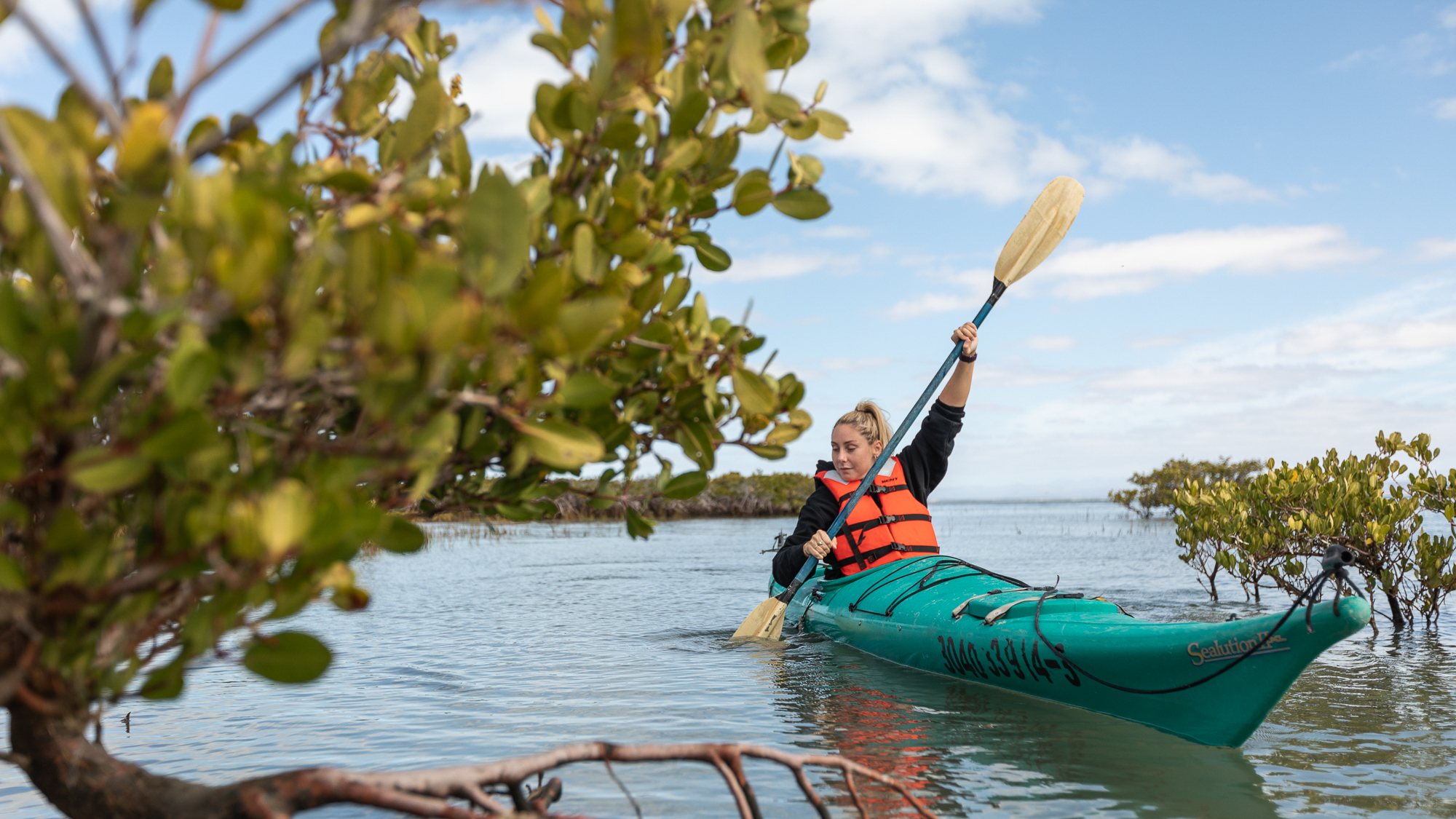
Combine Whale Watching in Baja with Other Activities
If you’re planning a whale watching trip to Baja California Sur, why not make it a full experience?
Baja is full of activities that pair perfectly with whale watching. We at Baja Expeditions offer tours that combine epic gray whale encounters in San Ignacio Lagoon with activities like sailing, surfing, kayaking, beach excursions, and marine safaris.
Whether you’re looking for a couples getaway or an action-packed family adventure, there’s a combo trip for you. Plus, all activities are suitable for various skill levels, and include the necessary equipment, making it easy to jump in and take part.
These tours run on exclusive dates during whale watching season and can vary in length from 4-12 days. Be sure to check Baja Expeditions’ latest itineraries to find the right trip for you!
What People Say About Baja’s Whale Watching Tours?
Don’t just take our word for it — here’s what past guests have shared about their whale watching experiences in Baja California Sur.
Frequently Asked Questions About Whale Watching In Baja
What is the best time of year for whale tours in Baja California?
In Baja California Sur, Mexico, the prime whale watching season runs from January through April.
How close can I get to whales in Baja, Mexico?
Whale watching in Baja is regulated by SEMARNAT, Mexico’s environment ministry. Boats without a whale watching permit must stay at least 244m (800ft) away from whales. Authorized boats with permits can legally get closer. For small boats, the minimum distance is 60m (200ft), for larger boats, it’s 80m (262ft).
San Ignacio Lagoon is a special case. As part of the El Vizcaíno Biosphere Reserve, it’s one of the only places in the world where gray whales may actively approach boats. Only licensed operators are allowed in these designated whale watching zones, and close encounters happen only if the whales initiate them. Touching the whales is never guaranteed and always on their terms.
How much do whale watching tours in Baja typically cost?
Whale watching experiences in Baja range from $85-150 for day trips to $1,500-4000+ for all-inclusive, multi-day expeditions, depending on duration, accommodations, and exclusivity.
What whale species can I see in Mexico?
Mexico’s Sea of Cortez hosts blue whales, humpbacks, fin whales, and sperm whales at various times of the year. You can observe gray whales in Baja’s Pacific lagoons.
What should I pack for whale watching in Baja?
Pack layers of clothing for variable weather, sturdy shoes, sun protection (hat, sunglasses, sunscreen), binoculars, a camera with a zoom lens, motion sickness medication if needed, and waterproof gear for potential spray during boat rides.
Are whale watching tours suitable for children?
Yes, most Baja whale watching operators, including Baja Expeditions, offer family-friendly experiences and welcome children. However, age restrictions may apply for certain remote expeditions or longer trips.
How does whale watching support conservation efforts?
Responsible whale watching tours in Baja contribute to conservation through adherence to strict approach guidelines, educational components, and economic alternatives to fishing in whale habitats.
